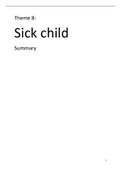Samenvatting
Theme 8: Ziek kind. Een complete samenvatting van alle tentamenstof!
- Instelling
- Rijksuniversiteit Groningen (RuG)
Op aanraden van mijn medestudenten verkoop ik nu mijn samenvattingen! In deze samenvatting maak ik veel gebruik van afbeeldingen, tabellen en opsommingen. Hierdoor hoef je geen lange lappen saaie en ingewikkelde tekst te lezen. In deze samenvatting staat alle stof van de boeken, colleges en leerdoe...
[Meer zien]




